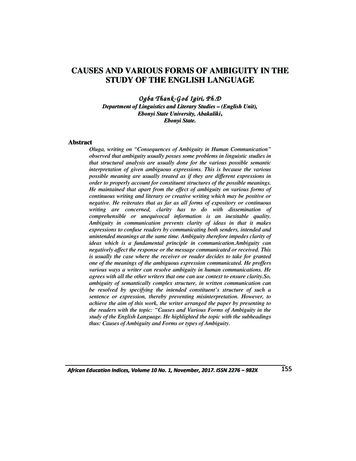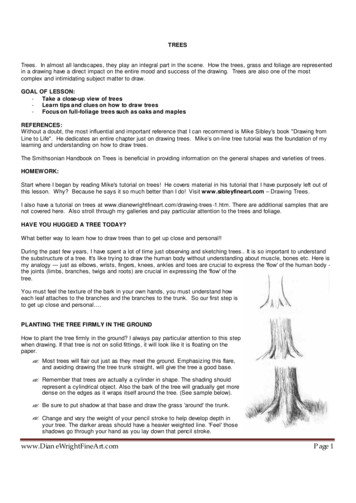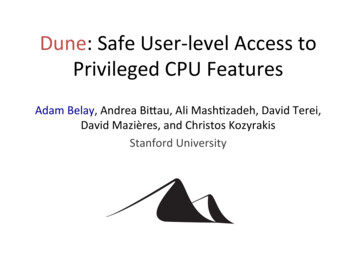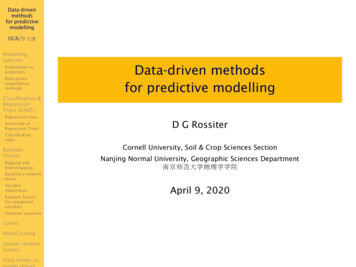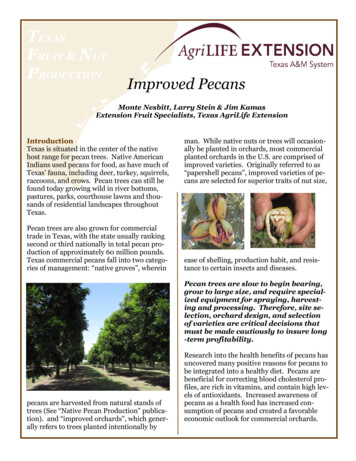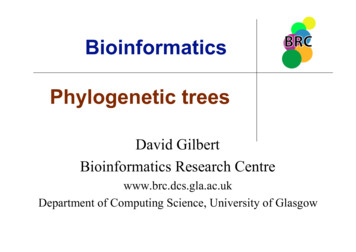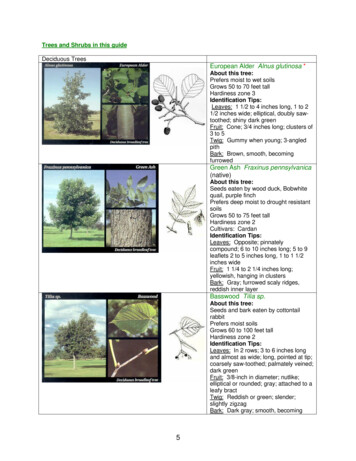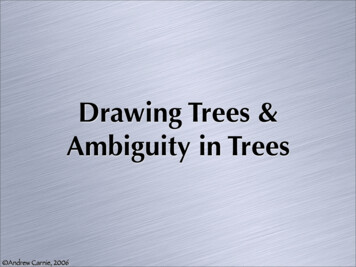
Transcription
Drawing Trees &Ambiguity in Trees Andrew Carnie, 2006
Some Phrase StructureRules of English Andrew Carnie, 2006
Some Phrase StructureRules of EnglishCP (C) TPTP {NP/CP} (T) VPVP (AdvP ) V (NP)({NP/CP}) (AdvP ) (PP ) (AdvP )NP (D) (AdjP ) N (PP ) (CP)PP P (NP)AdjP (AdvP) AdjAdvP (AdvP) Adv Andrew Carnie, 2006
Drawing trees Andrew Carnie, 2006
Drawing treesStep 1: Identify the parts of speech for all the words in thesentence Andrew Carnie, 2006
Drawing treesStep 1: Identify the parts of speech for all the words in thesentenceStep 2: try to figure out what words "go together in phrases" (i.e.figure out what the constituents are) Andrew Carnie, 2006
Drawing treesStep 1: Identify the parts of speech for all the words in thesentenceStep 2: try to figure out what words "go together in phrases" (i.e.figure out what the constituents are)Step 3: apply the rules backwards (bottom up) to build the tree. Andrew Carnie, 2006
Drawing treesStep 1: Identify the parts of speech for all the words in thesentenceStep 2: try to figure out what words "go together in phrases" (i.e.figure out what the constituents are)Step 3: apply the rules backwards (bottom up) to build the tree.Start with AdvP & AdjPs Andrew Carnie, 2006
Drawing treesStep 1: Identify the parts of speech for all the words in thesentenceStep 2: try to figure out what words "go together in phrases" (i.e.figure out what the constituents are)Step 3: apply the rules backwards (bottom up) to build the tree.Start with AdvP & AdjPsNext do NPs, then PPs, then VPs Andrew Carnie, 2006
Drawing treesStep 1: Identify the parts of speech for all the words in thesentenceStep 2: try to figure out what words "go together in phrases" (i.e.figure out what the constituents are)Step 3: apply the rules backwards (bottom up) to build the tree.Start with AdvP & AdjPsNext do NPs, then PPs, then VPsGenerally, start at the RIGHT edge of the tree andwork leftwards apply the TP rule last. Andrew Carnie, 2006
Drawing treesStep 1: Identify the parts of speech for all the words in thesentenceStep 2: try to figure out what words "go together in phrases" (i.e.figure out what the constituents are)Step 3: apply the rules backwards (bottom up) to build the tree.Start with AdvP & AdjPsNext do NPs, then PPs, then VPsGenerally, start at the RIGHT edge of the tree andwork leftwards apply the TP rule last.Step 4: now check your tree against your rules. Start at the top,and check that each set of lines can be generated by the rules. Andrew Carnie, 2006
Drawing trees Andrew Carnie, 2006
Drawing treesImportant: Andrew Carnie, 2006
Drawing treesImportant: Nothing can be left dangling in space. Andrew Carnie, 2006
Drawing treesImportant: Nothing can be left dangling in space. Everything has to be attached tosomething higher up. Andrew Carnie, 2006
Drawing treesImportant: Nothing can be left dangling in space. Everything has to be attached tosomething higher up. Lines can't cross one another. Andrew Carnie, 2006
Some treesThe very big man gave the marble Andrew Carnie, 2006to his son
Some treesD Adv Adj NVDNThe very big man gave the marble Andrew Carnie, 2006P DNto his son
Some treesAdvPD Adv Adj NVDNThe very big man gave the marble Andrew Carnie, 2006P DNto his son
Some treesAdjPAdvPD Adv Adj NVDNThe very big man gave the marble Andrew Carnie, 2006P DNto his son
Some treesAdjPNPAdvPD Adv Adj NVDNThe very big man gave the marble Andrew Carnie, 2006P DNto his son
Some treesAdjPNPAdvPD Adv Adj NVDNPNThe very big man gave the marble Andrew Carnie, 2006P DNto his son
Some treesNPAdjPNPAdvPD Adv Adj NVDNPNThe very big man gave the marble Andrew Carnie, 2006P DNto his son
Some treesNPPPAdjPNPAdvPD Adv Adj NVDNPNThe very big man gave the marble Andrew Carnie, 2006P DNto his son
Some treesVPNPPPAdjPNPAdvPD Adv Adj NVDNPNThe very big man gave the marble Andrew Carnie, 2006P DNto his son
Some treesTPVPNPPPAdjPNPAdvPD Adv Adj NVDNPNThe very big man gave the marble Andrew Carnie, 2006P DNto his son
Some treesThe big lazy dog bit a mouthful of food Andrew Carnie, 2006
Some treesD Adj Adj N V DNPNThe big lazy dog bit a mouthful of food Andrew Carnie, 2006
Some treesAdjPD Adj Adj N V DNPNThe big lazy dog bit a mouthful of food Andrew Carnie, 2006
Some treesAdjP AdjPD Adj Adj N V DNPNThe big lazy dog bit a mouthful of food Andrew Carnie, 2006
Some treesAdjP AdjPNPD Adj Adj N V DNPNThe big lazy dog bit a mouthful of food Andrew Carnie, 2006
Some treesPPAdjP AdjPNPD Adj Adj N V DNPNThe big lazy dog bit a mouthful of food Andrew Carnie, 2006
Some treesNPPPAdjP AdjPNPD Adj Adj N V DNPNThe big lazy dog bit a mouthful of food Andrew Carnie, 2006
Some treesNPAdjP AdjPNPPPNPD Adj Adj N V DNPNThe big lazy dog bit a mouthful of food Andrew Carnie, 2006
Some treesVPNPAdjP AdjPNPPPNPD Adj Adj N V DNPNThe big lazy dog bit a mouthful of food Andrew Carnie, 2006
Some treesTPVPNPAdjP AdjPNPPPNPD Adj Adj N V DNPNThe big lazy dog bit a mouthful of food Andrew Carnie, 2006
Some treesIwill finish an Andrew Carnie, 2006assignment about trees
Some treesNIT VDwill finish an Andrew Carnie, 2006NPNassignment about trees
Some treesNPNIT VDwill finish an Andrew Carnie, 2006NPNassignment about trees
Some treesNPNPNIT VDwill finish an Andrew Carnie, 2006NPNassignment about trees
Some treesPPNPNPNIT VDwill finish an Andrew Carnie, 2006NPNassignment about trees
Some treesNPPPNPNPNIT VDwill finish an Andrew Carnie, 2006NPNassignment about trees
Some treesVPNPPPNPNPNIT VDwill finish an Andrew Carnie, 2006NPNassignment about trees
Some treesTPVPNPPPNPNPNIT VDwill finish an Andrew Carnie, 2006NPNassignment about trees
A Personal Pet-peeveThe line in a tree represents the applicationof a PSR, so there is no line between a wordand its category: Andrew Carnie, 2006
A Personal Pet-peeveThe line in a tree represents the applicationof a PSR, so there is no line between a wordand its category:NPNPeanuts Andrew Carnie, 2006
A Personal Pet-peeveThe line in a tree represents the applicationof a PSR, so there is no line between a wordand its category:NPNPeanuts Andrew Carnie, 2006
A Personal Pet-peeveThe line in a tree represents the applicationof a PSR, so there is no line between a wordand its category:NPNPNNPeanutsPeanuts Andrew Carnie, 2006
AmbiguityAmbiguity: when a sentence has two meaningsParaphrase: A restatement of the meaning of asentence, used to disambiguate ambiguoussentences.John went to the bank.Paraphrase 1: John went to the financial institutionParaphrase 2: John went to the side of the riverWe use paraphrases to disambiguate. But be surethat when you draw trees you draw them of theORIGINAL sentence, not the paraphrase Andrew Carnie, 2006
AmbiguityTwo kinds:Lexical ambiguity uses words with morethan one meaning.Structural ambiguity ambiguous due to thestructure of the tree. Andrew Carnie, 2006
Lexically Ambiguous HeadlinesSafety Experts Say School Bus Passengers Should Be BeltedDrunk Gets Nine Months in Violin CaseIraqi Head Seeks ArmsFarmer Bill Dies in HouseStud Tires OutProstitutes Appeal to PopeBritish Left Waffles on Falkland IslandsReagan Wins on Budget, But More Lies AheadRed Tape Holds Up New BridgeDeer Kill 17,000Man Struck by Lightning Faces Battery ChargeBan on Soliciting Dead in Trotwood Andrew Carnie, 2006
Structurally Ambiguous Headlines?Two Sisters Reunited after 18 Years inCheckout CounterEnraged Cow Injures Farmer With AxHospitals are Sued by 7 Foot DoctorsKiller Sentenced to Die for Second Time in10 Years. Andrew Carnie, 2006
The Principle of Modification“The Golden Rule”If an XP modifies a head Y then XP must be Y’ssister (be the daughter of YP) Andrew Carnie, 2006
The Principle of Modification“The Golden Rule”If an XP modifies a head Y then XP must be Y’ssister (be the daughter of YP)YPXP Ysisters Andrew Carnie, 2006YPYXPsisters
Ambiguity in Structure Andrew Carnie, 2006
Ambiguity in StructureThe man put the book in the box on the table Andrew Carnie, 2006
Ambiguity in StructureThe man put the book in the box on the tableMeaning 1: put the book (currently in the box) onthe table. The box isn’t on the table Andrew Carnie, 2006
Ambiguity in StructureThe man put the book in the box on the tableMeaning 1: put the book (currently in the box) onthe table. The box isn’t on the table Andrew Carnie, 2006
Ambiguity in StructureThe man put the book in the box on the tableMeaning 1: put the book (currently in the box) onthe table. The box isn’t on the table Andrew Carnie, 2006
Ambiguity in StructureThe man put the book in the box on the tableMeaning 1: put the book (currently in the box) onthe table. The box isn’t on the tableMeaning 2: put the book into the box.The box is on the table. Andrew Carnie, 2006
Ambiguity in StructureThe man put the book in the box on the tableMeaning 1: put the book (currently in the box) onthe table. The box isn’t on the tableMeaning 2: put the book into the box.The box is on the table. Andrew Carnie, 2006
Ambiguity in StructureThe man put the book in the box on the tableMeaning 1: put the book (currently in the box) onthe table. The box isn’t on the tableMeaning 2: put the book into the box.The box is on the table. Andrew Carnie, 2006
Andrew Carnie, 2006
VPVputNPPPD N PP P NPthe bookonP NP D Ninthe tableD Nthe box Andrew Carnie, 2006
VPVPVputNPPPVputNPPPD N P NPD N PP P NPthe book inthe bookonD N PPP NP D Nthe boxinthe tableP NPD Non D Nthe boxthetable Andrew Carnie, 2006
Ambiguity in Structure Andrew Carnie, 2006
Ambiguity in StructureI killed the king with the knife Andrew Carnie, 2006
Ambiguity in StructureI killed the king with the knifeeasy reading: “used a knife for the killing” Andrew Carnie, 2006
Ambiguity in StructureI killed the king with the knifeeasy reading: “used a knife for the killing”harder reading: “king holding a knife” Andrew Carnie, 2006
Ambiguity in StructureI killed the king with the knifeeasy reading: “used a knife for the killing”harder reading: “king holding a knife”I killed the king with the red hair Andrew Carnie, 2006
Ambiguity in StructureI killed the king with the knifeeasy reading: “used a knife for the killing”harder reading: “king holding a knife”I killed the king with the red haireasy reading: “king who has red hair” Andrew Carnie, 2006
Ambiguity in StructureI killed the king with the knifeeasy reading: “used a knife for the killing”harder reading: “king holding a knife”I killed the king with the red haireasy reading: “king who has red hair”harder reading: “used red hair to kill him” Andrew Carnie, 2006
I killed the king with a knifekilled using a knifeTPNPVPking holding a knifeTPNPVPNV NPI killedD N PPD N P NPthe kingthe king withP NPDNwithaknifeDNaknifeNV NP PPI killed Andrew Carnie, 2006
I killed the king with red hairkilled using red hairTPNPVPred-headed kingTPNPVPNV NPI killedD N PPD N P NPthe kingthe king withAdjP Nwith P NPhairAdjP NAdjhairAdjredred Andrew Carnie, 2006NV NP PPI killed
Summary Andrew Carnie, 2006
SummaryTree drawingpractice, practice, practice Andrew Carnie, 2006
SummaryTree drawingpractice, practice, practiceApply rules from bottom up, start withAdjPs, AdvPs, NPs, PPs first. Start fromright edge. Andrew Carnie, 2006
SummaryTree drawingpractice, practice, practiceApply rules from bottom up, start withAdjPs, AdvPs, NPs, PPs first. Start fromright edge.Make sure everything is connected, nocrossing lines. Andrew Carnie, 2006
SummaryTree drawingpractice, practice, practiceApply rules from bottom up, start withAdjPs, AdvPs, NPs, PPs first. Start fromright edge.Make sure everything is connected, nocrossing lines.CHECK your trees against the phrasestructure rules. Andrew Carnie, 2006
Summary Andrew Carnie, 2006
SummaryStructurally vs. Lexically ambiguous. Andrew Carnie, 2006
SummaryStructurally vs. Lexically ambiguous.Structurally ambiguousdifferent meanings have different trees.relies on the principle of modification! Andrew Carnie, 2006
SummaryStructurally vs. Lexically ambiguous.Structurally ambiguousdifferent meanings have different trees.relies on the principle of modification!A paraphrase is a restatement ofmeaning. Don’t draw trees for theparaphrase -- draw them for theactual sentence. Andrew Carnie, 2006
Meaning 1: put the book (currently in the box) on the table. The box isnÕ t on the table Meaning 2: put the book into the box. The box is on the table. Andr ew Carnie, 2006 Ambiguity in Structure. Andr ew Carnie, 2006. put ! ! ! ! D N! ! ! ! the box! ! ! ! D N. D N .
